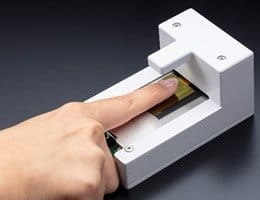
Views: 43
– Joint R&D With University of Tokyo Leads to World’s First Thin Image Sensor that Can Measure Fingerprints, Veins, and Pulse Waves
Minapim by Hernan Valenzuela: An extremely thin sensor worn around the finger or arm can measure pulses and scan fingerprints and vein patterns, thereby preventing identification mix-ups among medical patients and nursing care residents, the device’s developers said.
The scientists from the University of Tokyo and Japan Display Inc. said that the sensor equipment works like a camera.
It consists of a thin film transistor and an optical sensor placed on a sheet. Development was based on organic electroluminescence technology, they said.
“Both the high-resolution imaging and high-speed data readout were realized at the same time,” said Takao Someya, an electrical engineering professor at the university.
Although it was difficult to place the tiny parts on the thin sheet, the process was completed by lowering temperatures and improving the agent used in the manufacturing process.
The device is around 0.015 millimeter thick, and it can be bent or pasted on an arm.
“We will pitch the sensor to the market within three years or so,” said Akio Takimoto, a senior fellow at Japan Display’s R&D Division.
Under the plan, the sensor will be further refined to measure not only pulses but also blood sugar levels and blood oxygen content. The team is considering adopting a battery so the sensor can be used as a health care appliance for a prolonged period like a wristwatch.
More about:
Integrating low-temperature polysilicon thin-film transistors with high mobility and high-sensitivity organic photodectors has enabled to create a single sensor that measures not only pulse wave distribution, which requires high-speed readout, but also biometric information, such as fingerprints and veins, which require high-resolution imaging. A mere 15 micrometers thick, the sensor is light weight and bendable. As for biometric authentication, it is expected that the sensor will be applied to high security authentication systems to prevent imitations and impersonations by obtaining both biometric information (fingerprints and veins) and biometric signals (pulse waves).
The development was reported in the British scientific journal Nature Electronics at (https://nature.com/articles/s41928-019-0354-7).
Sources: The Asahi Shimbum Tokyo University Japan Display Inc
Related article: Wearable electronics, how nanotechnology enables
Did you like the article? Sign for free newsletter !